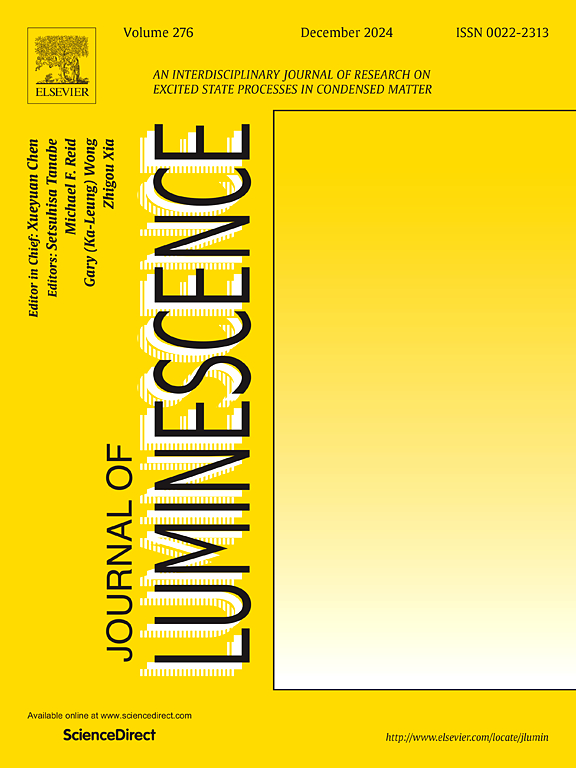Ultra-broadband near-infrared-I and II emission from chromium doped double perovskite for multifunction application
IF 3.6
3区 物理与天体物理
Q2 OPTICS
引用次数: 0
Abstract
Broadband near-infrared phosphor converted light-emitting diode (NIR pc-LED) has been widely concerned as a generation of light source. However, the preparation of ultra-broadband NIR phosphors with long wavelength emission remains challenging. In this study, Cr3+-doped double perovskite-type GdTiTaO6 (GTTO) phosphors were successfully prepared using the high-temperature solid-state reaction. The phosphors exhibit ultra-broadband NIR emission spanning 700–1400 nm, with a peak center at 940 nm and a full width at half maximum (FWHM) of 260 nm, which is ascribed to the strong electron-phonon coupling effect (EPC). A NIR pc-LED device was fabricated by integrating GTTO: 0.03Cr3+ phosphors with a 470 nm emissive LED-chip. Benefit from the ultra-broadband emission, the LED shows promising application in the night vision and transmission due to the NIR-I emission. In addition, a testing platform was creatively built for the first time. The platform realizes the non-destructive and rapid detection of ethanol concentration and the detection of fruit moisture, verifying the multi-functional application of GdTiTaO6: Cr3+ phosphor.
掺铬双钙钛矿多功能应用的超宽带近红外i和II发射
宽带近红外荧光粉转换发光二极管(NIR pc-LED)作为新一代光源已受到广泛关注。然而,制备长波发射的超宽带近红外荧光粉仍然是一个挑战。本研究采用高温固相反应法制备了Cr3+掺杂双钙钛矿型GdTiTaO6 (GTTO)荧光粉。该荧光体表现出700 ~ 1400 nm的超宽带近红外发射,峰中心位于940 nm,半峰全宽为260 nm,这归因于强电子-声子耦合效应(EPC)。采用GTTO: 0.03Cr3+荧光粉与470nm发光led芯片集成,制备了近红外pc-LED器件。得益于超宽带发射特性,LED在夜视和传输方面具有广阔的应用前景。此外,还创造性地首次搭建了测试平台。该平台实现了乙醇浓度的无损快速检测和水果水分的检测,验证了GdTiTaO6: Cr3+荧光粉的多功能应用。
本文章由计算机程序翻译,如有差异,请以英文原文为准。
求助全文
约1分钟内获得全文
求助全文
来源期刊

Journal of Luminescence
物理-光学
CiteScore
6.70
自引率
13.90%
发文量
850
审稿时长
3.8 months
期刊介绍:
The purpose of the Journal of Luminescence is to provide a means of communication between scientists in different disciplines who share a common interest in the electronic excited states of molecular, ionic and covalent systems, whether crystalline, amorphous, or liquid.
We invite original papers and reviews on such subjects as: exciton and polariton dynamics, dynamics of localized excited states, energy and charge transport in ordered and disordered systems, radiative and non-radiative recombination, relaxation processes, vibronic interactions in electronic excited states, photochemistry in condensed systems, excited state resonance, double resonance, spin dynamics, selective excitation spectroscopy, hole burning, coherent processes in excited states, (e.g. coherent optical transients, photon echoes, transient gratings), multiphoton processes, optical bistability, photochromism, and new techniques for the study of excited states. This list is not intended to be exhaustive. Papers in the traditional areas of optical spectroscopy (absorption, MCD, luminescence, Raman scattering) are welcome. Papers on applications (phosphors, scintillators, electro- and cathodo-luminescence, radiography, bioimaging, solar energy, energy conversion, etc.) are also welcome if they present results of scientific, rather than only technological interest. However, papers containing purely theoretical results, not related to phenomena in the excited states, as well as papers using luminescence spectroscopy to perform routine analytical chemistry or biochemistry procedures, are outside the scope of the journal. Some exceptions will be possible at the discretion of the editors.
 求助内容:
求助内容: 应助结果提醒方式:
应助结果提醒方式:


